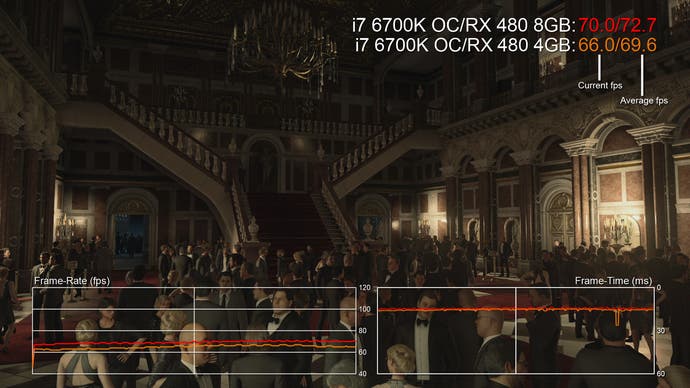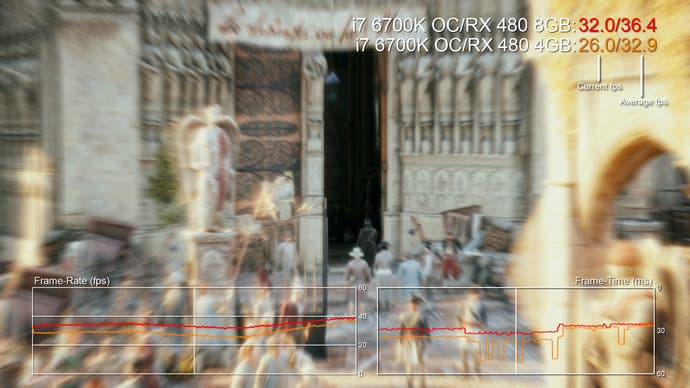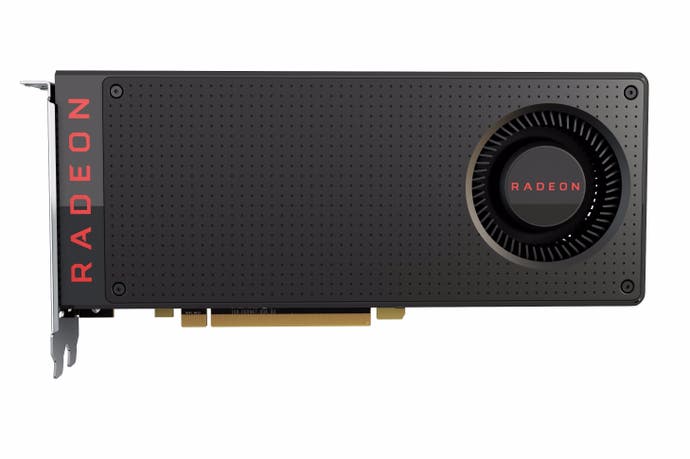AMD Radeon RX 480 4GB vs 8GB review
Do you really need to spend more for the extra RAM?
We have unfinished business with the Radeon RX 480. When we initially reviewed the card, we took a look at the 8GB reference version - as supplied by AMD. However, the main selling point of the product is the $199 price-tag, which sees us move firmly into 4GB territory. UK prices for this model are highly reasonable too, starting at around £180. This makes the RX 480 stand apart significantly from the recently released Nvidia GeForce GTX 1060 - a clear $50/£60 price differential.
So going into this article, we have three major questions to address. Firstly, do you really need the 8GB of framebuffer memory for the more expensive version of the RX 480? Secondly, is there any performance differential between the two models in scenarios where we're not limited by memory? And how does the four gig card stack up against the GTX 1060 bearing in mind that it's a lot cheaper?
First of all, let's take a look at the fundamental differences between the two versions of the RX 480. Basically, the products are physically identical: it's the same chassis, the same IO connectors (three DisplayPorts, one HDMI 2.0), the same six-pin power input and the same software feature-set. The GPU core is identical too, with the same base and boost clocks. However, the 4GB version of the RX 480 features memory modules rated for 7gbps, while the 8GB release gets a small upgrade here - 8gbps RAM. The end result is simple - 224GB/s bandwidth on the cheaper card vs 256GB/s on the top-tier model.
- Buy the AMD Radeon RX 480 from Amazon with free shipping.
In order to assess any performance difference between the two cards, AMD sent us a new vBIOS for our 8GB card, disabling four gigs and emulating the memory available on the cheaper card. We then moved into AMD's new overclocking tool - WattMan - and manually reduced the memory speed settings to accurately match the reduced bandwidth of the cheaper Radeon. We also updated the AMD driver, which did indeed alter our initial review benchmarks scores.
During the review process, several outlets noticed that the RX 480 was out-of-spec in terms of its power draw - this revised driver addressed that problem and also rolled in some performance optimisations. We were concerned that this fix would have a small impact on frame-rate, but as it stands, we noted a three per cent improvement. Hardly earth-shattering in the greater scheme of tings, but interesting nonetheless.
We consider the RX 480 suitable for 1080p and 1440p gaming, so we carried out the tests at both resolutions, and tossed in our GTX 1060 metrics too, bearing in mind that it is the closest competing product that Nvidia has in challenging AMD's new mainstream flagship. The end result? The 4GB edition of the RX 480 is slower, but it's not likely to impact the gameplay experience to any noticeable degree.

| 1920x1080 (1080p) | RX 480 4GB | RX 480 8GB | R9 390 8GB | GTX 1060 6GB | GTX 970 4GB |
|---|---|---|---|---|---|
| Assassin's Creed Unity, Ultra High, FXAA | 50.4 | 50.8 | 48.6 | 58.2 | 51.3 |
| Ashes of the Singularity, Extreme, 0x MSAA, DX12 | 45.9 | 47.7 | 52.1 | 45.9 | 40.5 |
| Crysis 3, Very High, SMAA T2x | 68.8 | 70.1 | 75.4 | 78.7 | 72.5 |
| The Division, Ultra, SMAA | 53.6 | 54.8 | 49.8 | 56.6 | 50.2 |
| Far Cry Primal, Ultra, SMAA | 57.1 | 58.7 | 65.1 | 65.6 | 56.2 |
| Hitman, Ultra, SMAA, DX12 | 71.4 | 73.2 | 75.6 | 65.8 | 59.0 |
| Rise of the Tomb Raider, Ultra, SMAA, DX12 | 59.8 | 61.2 | 66.6 | 75.1 | 69.7 |
| The Witcher 3, Ultra, Post AA, No HairWorks | 60.5 | 61.2 | 55.6 | 68.4 | 60.7 |
The improvement in performance with the faster card ranges from a mere one per cent (The Division at 1080p) to a more substantial nine per cent (Assassin's Creed Unity at 1440p - a game notorious for VRAM utilisation, something we'll move on to shortly). However, generally speaking, the average differential is more in the three to four per cent range. Translated into frame-rates, that's anything from 1-3fps. That's not exactly much to write home about, but it illustrates that memory bandwidth can have an impact on game performance, even when the GPU silicon itself runs at identical clock-speeds.
So are there ways to improve performance on the 4GB card to match the more expensive version? Well, there are two options available here that can be used in isolation, or together in concert. Both involve adjusting some settings in WattMan - AMD's overclocking tool. You can find this by right-clicking on the desktop, selecting AMD Radeon settings, then global settings and then selecting the global WattMan tab on the top-right.
First up, you can attempt to overclock the memory to match the speeds of the more expensive model. On the 4GB card, memory frequency will be set to 1750MHz (you multiply by four to get its actual in-game speed). Adjusting to 2000MHz will put you on par with the more expensive card. The question is whether the RAM on your card will overclock to that extent. Load up a taxing game, alt-tab out and gradually increase by 200MHz increments, hitting the apply button each time. Dial back if there are any signs of instability - for example, artefacting on-screen or indeed hard crashes. You should be able to hit 2000MHz on most cards, but mileage can vary from one example to the next. Instability with a memory overclock can be countered by increasing the power level in WattMan. Click the temperature switch, then move the power limit up, before hitting the apply button.

| 2560x1440 (1440p) | RX 480 4GB | RX 480 8GB | R9 390 8GB | GTX 1060 6GB | GTX 970 4GB |
|---|---|---|---|---|---|
| Assassin's Creed Unity, Ultra High, FXAA | 31.0 | 33.8 | 33.7 | 37.4 | 32.7 |
| Ashes of the Singularity, Extreme, 0x MSAA, DX12 | 40.7 | 42.7 | 46.2 | 41.2 | 35.9 |
| Crysis 3, Very High, SMAA T2x | 41.8 | 43.1 | 48.7 | 47.7 | 43.8 |
| The Division, Ultra, SMAA | 38.1 | 39.0 | 37.8 | 39.9 | 36.1 |
| Far Cry Primal, Ultra, SMAA | 40.7 | 42.3 | 46.7 | 45.0 | 39.6 |
| Hitman, Ultra, SMAA, DX12 | 52.2 | 55.0 | 56.8 | 48.1 | 41.5 |
| Rise of the Tomb Raider, Ultra, SMAA, DX12 | 41.7 | 43.0 | 46.0 | 49.2 | 46.1 |
| The Witcher 3, Ultra, Post AA, No HairWorks | 43.5 | 45.3 | 42.9 | 48.2 | 31.9 |
But there's another approach to slightly faster frame-rates too. The RX 480 boost clock is 1266MHz, but we have noted that in graphically intense games, that clock speed can throttle back to 1180MHz or thereabouts. Simply by increasing the power level +10 per cent over the current level sends more power to the GPU core and the clock-speeds increase, often locking at the max 1266MHz boost. Typically, this can add three per cent of additional performance and the core will still be stable. However, more power is being pumped through the GPU, so it will get hotter - and the end result of that is an increase in fan speeds to compensate. In short, your card may get a little louder.
This is more likely to be noticeable on a reference RX 480 - the design featured on this page. Partner cards from the likes of MSI, Asus and Sapphire use more advanced cooling solutions, and in these cases, it's quite unlikely that adding an additional ten per cent of power will cause much in the way of increased fan noise at all. To illustrate the performance differential, we instigated both of these adjustments on Far Cry Primal at 1440p. The 8GB card is 3.9 per cent faster in our tests here at 40.7fps, but with the adjustments in place, the 4GB version inches ahead - 43.6fps vs the stock 8GB card's 42.3fps. But it is worth noting that using this power boost technique will aid the 8GB model too, as its performance also seems to be constrained by its power budget.
The overall increases are minimal though and while it's nice to have, it won't impact gameplay that much. This changes significantly when it comes to maxing out memory though - and that's where the nine per cent gain we saw with the 8GB card in Assassin's Creed Unity comes into the focus. At 1440p, VRAM in our bench scene is tested to the limits, the memory allocation goes over 4GB and stutter intrudes, as you can see in the image below. However, while this test is repeatable with similar results, it seems to be something of an outlier here - we tested actual gameplay and saw none of the same stutter. That said, it is conceivable that games with high RAM requirements could be pushed beyond the four gig threshold if you use multi-sampling anti-aliasing, but as this tends to hit frame-rates by anything upwards of 20 per cent vs standard post-process AA, we typically can't recommend it in modern titles.
So what of the titles that do push beyond the 4GB limit? There are games out there using higher resolution textures (Gears of War Ultimate, Rise of the Tomb Raider, Doom, Mirror's Edge) that could conceivably cause issues as 6GB is typically the preferred memory limit there. Well, here's the thing - the actual visible payback for utilising these assets at the 1080p resolution the RX 480 works best at is actually rather minimal. Case in point: you can run the Nightmare texture-paging option in Doom, but there's little actual reason to do so.
And it's a similar state of affairs with Mirror's Edge - but the game's status as a VRAM glutton in hyper mode seems to have changed since we tested it at launch. When we first looked at it, we found that hyper mode absolutely crippled performance on four gig cards like the entry-level RX 480. However, when we returned to it for GTX 1060 testing, its VRAM issues had been cleaned up and performance suddenly looks a whole lot better - with no real difference between four gig and eight gig models.
But again, even with hyper mode engaged, the improvement in visuals at 1080p isn't at all game-changing - and it never has been, really. You're missing nothing earth-shattering simply by staying at ultra, which offers up the vast majority of the improvements compared to the console versions of the game. The principal benefit there is the increased horsepower: Mirror's Edge at native 1080p offers a significantly refined experience compared to the 900p PS4 game and 720p Xbox One title. Higher resolution - and smoother performance too. Let's not forget the RX 480's principle draw: the ability to match or exceed console quality and run multi-platform games at 1080p60.
Radeon RX 480 4GB vs 8GB - the Digital Foundry verdict
The bottom line here is pretty clear. Yes, packaging the $199 version of the RX 480 with slower 7gbps memory modules sees a slightly lower level of performance compared to the more expensive 8GB card. However, in the vast majority of scenarios, you're looking at only a one to four percent advantage by investing in the more expensive card. In terms of the actual gameplay experience that's delivered, the two versions of the product hand in very similar returns - certainly not enough to justify the 8GB model's additional $40. Remember, that's an extra 20 per cent on the base cost of the card.
But what you are buying is a certain level of future-proofing. Since the arrival of the current generation of consoles, VRAM utilisation in games has only moved in one direction - upwards. Three or four gigs at 1080p is fine for now, but the question is really what's going to happen as we move forward, particularly as Microsoft is strongly hinting that its next-gen Project Scorpio features 12GB of memory in order to power its 4K vision.
But as a 'here and now' type of purchase, the entry-level $200 Radeon RX 480 has much to commend it and while it'll save you $40 compared to the eight gig version, you save even more compared to more expensive Nvidia's GTX 1060, which has 6GB of onboard memory. Factoring in the benchmarks above, you do have to wonder whether the Nvidia card can justify a 25 per cent price premium (this actually rises to 32 per cent in the UK at current prices). Both versions of the RX 480 - and indeed the GTX 1060 - are excellent products overall, but when it comes to price vs performance, the four gig Radeon is simply in a class of its own.











